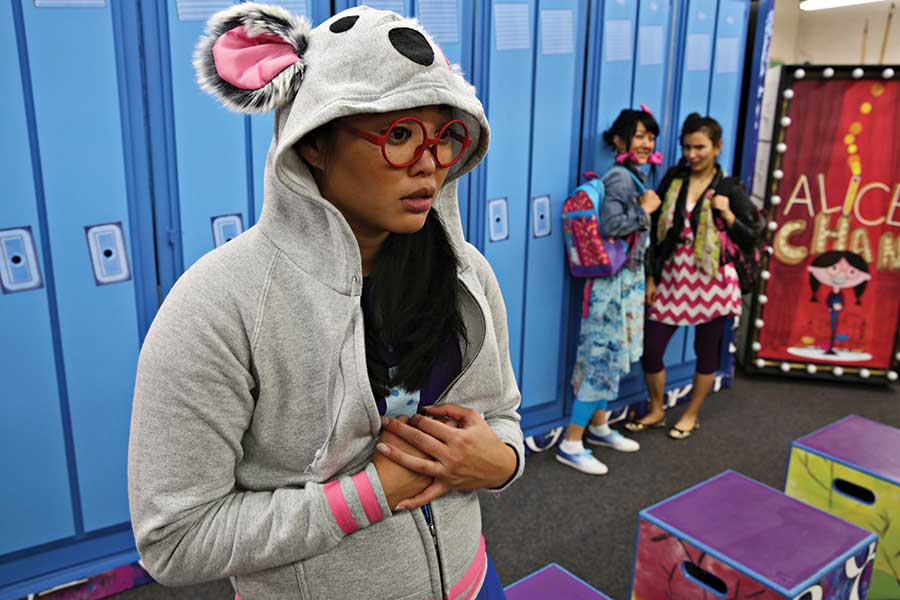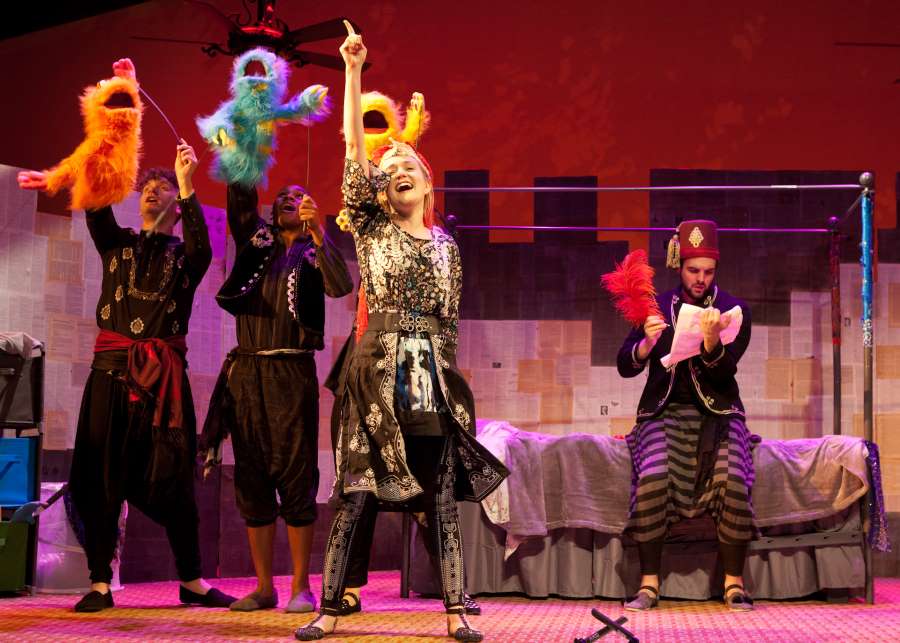It might seem strange to think of The Velveteen Rabbit playing in the same space as a David Mamet play, but the Atlantic Theater Company in New York City programs just that. The Off-Broadway nonprofit, cofounded by the Glengarry Glen Ross playwright, has been running its Atlantic for Kids series for the past 15 years. The lineup serves as a bridge between the company’s artistic programming and education initiatives and produces two kid-friendly productions a year—some even written by Mamet himself.
“The distilled mission of the Atlantic, which is ‘to produce great plays simply and truthfully by utilizing an artistic ensemble,’ is at the heart of Atlantic for Kids,” says Alison Beatty, the school artistic director at Atlantic. “The story of a play and the intent of its playwright are at the core of the creative process for all of Atlantic’s programming, and Atlantic for Kids is no exception.”
According to Theatre Communication Group’s 2014 Theatre Facts survey, the number of children’s series like Atlantic for Kids is on the rise. The survey defines this programming as a “production series for young audiences by theatres that are not Theatre for Young Audience (TYA) theatres,” and finds that both their audience turnout and number of performances have increased over the past five years. While aging audiences remain a concern across arts disciplines, children’s series are introducing school groups and families to theatres that otherwise feature more adult-oriented work.
Many of these productions are commissions or world premieres, and use the same talent and resources that companies put toward the rest of their programming. La Jolla Playhouse’s Performance Outreach Program (POP) Tour commissions a new work for young audiences every year and brings the world premiere to 20,000 elementary school students annually. Past collaborators include B.D. Wong, Karen Zacarías, and Julia Cho.
“The benefit of developing TYA productions at La Jolla Playhouse is that we have an amazing team of artists who work here creating some of the most exciting and innovative theatre you will ever experience,” says Steve McCormick, director of education and outreach at La Jolla Playhouse. “These artists bring the same passion they have for our mainstage work to their work on the POP Tour. As a result, our touring shows are of a quality you may not find in touring productions from smaller theatres.”
Earlier this month, Steppenwolf for Young Adults (SYA), the education wing of Chicago’s Steppenwolf Theatre Company, premiered The Burials by Caitlin Parish (TV’s Under the Dome, Supergirl). The play, commissioned by the company, draws from Antigone to examine gun violence from a teen’s perspective. Hallie Gordon, artistic director of SYA, notes the way the commissioning process supports Steppenwolf’s overall goals for new-play development.
“The process of commissioning writers and hopefully creating a canon of new plays to add to the national theatre conversation is very similar to what we, as an artistic staff, do for all our plays,” she says. “The only difference is SYA has a more in-depth way of working with our constituents, which are our teachers, students, and families. There is a rigor to our engagement that not only deals with art-making but also themes as we try to create an environment that allows our audience to see and understand artistic choices.”
Beatty at Atlantic for Kids points out that TYA can offer new creative challenges to artists in Atlantic’s network. “I think working within a larger company allows us an exciting amount of freedom in our programming,” she says. Most recently, Atlantic for Kids produced 1001 Nights, A Story About Loving Stories by Robert Lopez (Avenue Q, Frozen) and Adam Koplan. The pair wrote the musical together almost 20 years ago, but approached Atlantic for Kids about giving it a new production. Both worked closely on the show, with Lopez writing a new song and Koplan directing. “They wanted to revisit it now that they have children of their own to share it with,” says Beatty.

While the children’s series producing model offers many perks that TYA-specific theatres don’t have, there are drawbacks as well. Production values, performance schedules, and production calendars are often dictated by the needs of a mainstage production running at the same time, and many children’s series perform on top of a mainstage production’s set.
“In one respect, our family shows are housed in a beautiful Off-Broadway theatre and all of the amenities that come with the facility,” says Beatty. “On the other hand, there are obvious challenges that we face when producing a show on top of another show. All in all, I have found that we have been successful in finding creative solutions when working within the given limitations. We have fully realized productions and create unique design worlds for the Atlantic for Kids shows, not in spite of but because of these challenges.”
“The biggest challenge we face is one of capacity,” adds McCormick of La Jolla Playhouse. “La Jolla Playhouse is on the campus of the University of California—San Diego. Our shops are responsible for all the university productions as well as the Playhouse shows meaning that they can be building more than twenty shows a year. It can be a challenge to find the space to build and rehearse the physical production of the POP Tour with so much else going on.”
Department staffing can also be an issue. “We are understaffed and have been for a while,” admits Steppenwolf’s Gordon. “It’s amazing the amount of work we do with only two-and-a-half full-time staff members.”
Despite the challenges, children’s series can be hugely rewarding. Gordon observes overlap between SYA theatregoers and the larger Steppenwolf audience. “We definitely have subscribers who see our shows as well as university students and general public as well,” she says. “We have had our Young Adult Council Alumni start giving back to the theatre, which is amazing to see. The YAC is celebrating its 10th anniversary, so those kids are now in their mid-20s.”
McCormick notes that producing TYA expands La Jolla Playhouse’s circle of colleagues. “The joy of being a company that does work for both adult and young audiences means that we can talk to any theatre and be able to relate to them on an appropriate level,” he says. “Our network is huge as we do not pigeonhole ourselves as a company that does theatre for only one sort of audience.”
The sense of purpose and community engagement that comes with bringing the arts to children is a powerful motivator as well. “For many of the students at these schools, this is the first time they have ever seen a live play,” says McCormick. “It is an exciting responsibility for us to produce plays that are of the highest standards to ensure that students and teachers will want to see more theatre in the future.”
And Beatty wants theatres who might be considering adding TYA programming to their lineup to remember that kids are “the most intelligent and honest audience members” they can find.
“They will only laugh when they are moved to do so, and will only applaud when they are genuinely compelled to do so, for better or for worse,” she says. “That said, the joy of hearing a house full of children laughing is well worth the risk.”


